
|   |

|   |
 e-mail: sunilkothari1933@gmail.com Singapore and Kuala Lumpur Diary December 11, 2017 Singapore Diary Photos courtesy: Apsaras Arts I arrive by 3pm at the stage door of Singapore's Esplanade main theatre to see rehearsal of Anjaneyam: Hanuman's Ramayana. I have to submit my passport to enter. Three years ago when I attended Angkor: An Untold Story rehearsal, I had gone through this exercise. Abroad, be it Lincoln Centre in New York, The Kennedy Centre in Washington DC, Barbican in London, Opera House in Sydney, the authorities insist on this strict procedure to safeguard against any untoward event. But in India, anyone can walk in backstage, and no one is bothered. I think we need to follow this procedure. I read the other day that at Ravindra Bharathi Auditorium in Hyderabad, several purses and mobile phones were stolen from green room when the performance was on. In past in Mumbai at Bharatiya Vidya Bhavan, thieves walked in and stole Grundig German tape recorder and valuables of dancers. Of late in Mumbai precaution is being taken at NCPA and other major theatres. Dancers beware in India. 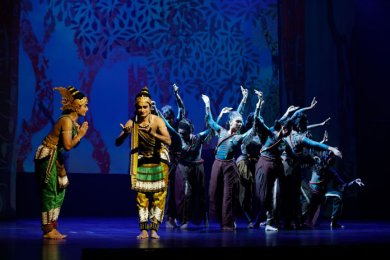
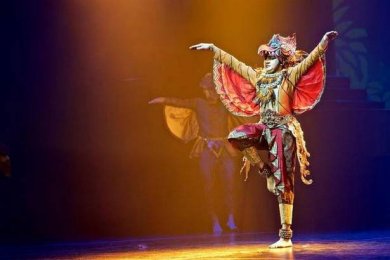
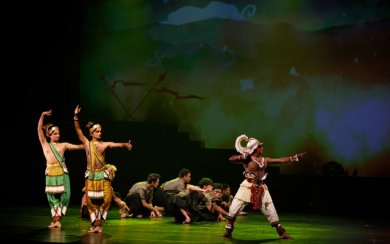
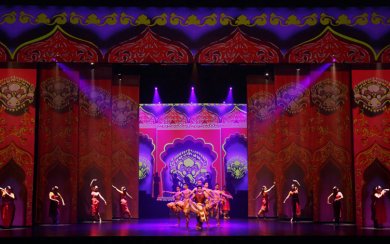
I saw in the orchestra pit, Dr. Rajkumar Bharathi and his team of musicians including Abhishek Raghuram, Savita Narasimhan, Srikanth Gopalakrishnan and others humming, instruments were being tuned, Javanese musicians of Bimo Dance Theatre looking after Gamelan, on lights the ace light designer Gyan Dev Singh, projection animator from Knownsense studios, sound designer and musician who had been to Singapore two months ago for mapping the theatre for 3D quartered sound effect, and on stage from Chennai, Lavanya Ananth, who played the role of Sita, Hari Padman from Kalakshetra, who played main role of Hanuman, artistic director Aravinth Kumarasamy who had visualized this mega production, rehearsal master Renjith Babu, several dancers from Apsaras Arts, guest Kalakshetra artists and choreographer Mohanapriyan Thavarajah, who played roles of Indrajit, Jatayu and Vayu Devata, Javanese dancer Osman Abdul Hamid who played role of Ravana in Javanese dance style, and several others. On the large screen were projected colorful scenes of forest with trees, leaves falling from branches of the trees, birds chirping and flying - one was transported to a magic world. The melodious singing by Savita Narasimhan filled the hall. Rajkumar spoke about Vilaskhani Todi echoing the wailing agony of Sita separated from Lord Rama and taken as captive in Ashoka vana in Srilanka. It was like a jigsaw puzzle. Jayanti Subramaniam had choreographed Sita's role in July in Chennai and it was now being rehearsed with live music, light and sound design. Aravinth, Rajkumar Bharathi, Gyan Dev Singh, Sai Shravanam, visual media designer Himanshu Gosh all wore head phones conversing for cues. Sometimes cues were not in time. Light designer was told to focus light on a dancer's face for expression to be registered. Watching this process, I was quite amazed at how the whole production was being put in order. Travelling with director Ratan Thiyam abroad, watching rehearsals backstage in Brooklyn Academy of Music theatre (BAM) in New York and in other cities, I was used to seeing the shaping of the plays with lighting, sound, music and dance. Therefore, this privilege to watch Anjaneyam being performed in different sections was fascinating. As a matter of fact, Aravinth told me that for three days they would rehearse to see that everything is perfect. The pre-view with costumes would give a glimpse of how it would be staged on opening night. More than 100 persons were involved in mounting this production on a grand scale. A theatre like Esplanade with excellent infrastructure made it possible to realize Aravinth's dream. But it was indeed important to dream and hard work for more than a year coordinating several aspects was a Herculean task. To enlist support of various dance companies from Indonesia, Chennai, Singapore, musicians local and from abroad and seamless weaving of all together for final artistic confluence is no easy task. I am grateful for being invited three days in advance to watch the entire process, acquainting me with how things were working, and meeting the technicians, artists, musicians and move freely backstage amongst them, asking them questions, watching the organization and listening to the lyrics set in various Hindustani and Carnatic ragas, musical effects and the total ambience. It was heartening to see the cooperation and bonhomie among them. Unlike Angkor, this time Aravinth had commissioned projections of backdrops in colourful paintings. Sea waves, mountains, forests, royal court of Ravana, Lanka set on fire, Hanuman flying across the sea, bringing Sanjivini plant with the hillock, and the final battle. With clever ploy the only heavy set was high stage on either side from which Rama and Ravana fight. When golden deer appears, excellent setting of dark forest with several galloping deer, among them one with its contours lit up as golden deer were used. Sometimes to show simultaneous event, the screen was split into two to suggest same time - a cinematic effect. Also carrying forward the narrative, flashback was used, and imaginative use of chorus, a la Greek theatre, reflecting what the main character is thinking. For instance, five apsaras circle round Sita when she plans to hang herself from branch of a tree by her long braid. The apsaras hold long braid in their hand, stretch them and circle round Sita. Before she tries to hang herself, Hanuman jumps praying Sri Rama Jaya Rama Jaya Jaya Rama. Then when Sita narrates her plight, how Ravana kidnapped her and Jatayu fought valiantly, the use of flashback is done imaginatively. From green rooms allotted to the artists emerge Dhananjayan, Shantha and Balagopal. Our friendship goes back for more than 60 years. We reminisce about our meetings at Kalakshetra, their performances in Mumbai in 1957 during Vegetarian Congress - Sita Swayamvaram dance drama was staged for the conference at Bharatiya Vidya Bhavan. Dhananjayan and Balagopal were performing on stage after 50 years! Dhananjayan had left Kalakshetra, but Balagopal had continued to play role of Hanuman for which he has become a legendary figure. He has trained Hari Padman well as his successor. In Anjaneyam, Dhananjayan appears in Prologue and Epilogue as Valmiki visiting Himalayas in his twilight years and sees Ramayana written on stone by Hanuman. Their meeting is very emotional - in real life and during the dance drama. Valmiki praises Hanuman's Ramayana but Hanuman says that Valmiki's is best and throws away his in the ocean. It is said that Valmiki takes avatar of Tulasidas and writes Ramcharitamanas as tribute to Hanuman. Their brief appearance is very moving. It is a brilliant artistic coup in featuring these two veteran artists. 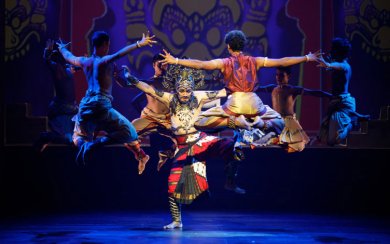
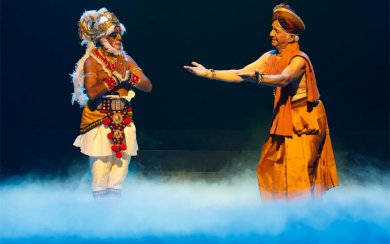
The final show was on 17th November. It was amazing how Aravinth managed to mount this large scale production featuring dancers and musicians from Singapore, Indonesia and India, convincing Esplanade to join hands and part finance it. The costume designer Mohanapriyan Thavarajah showed me the exquisite costumes he had designed for various characters like Ravana's royal robes, the crowns, headgear of Hanuman and so on. The story is well known. Drawing from other Ramayanas and Javanese Kakawin Ramayana, Aravinth has woven the story, with flashback, at times narrated by musicians, palaces move and forests appear, sea waves roar and Hanuman flies, sets fire to Srilanka - lighting and sound create astounding effect. Such a large scale production deserves to be seen in other cities in India, where Ramayana is known to everyone and its performances are a living tradition. Even when we do not have anything to compare with Esplanade Theatre in Singapore, NCPA in Mumbai, Sir Mutha Venkatasubba Rao Concert Hall in Chennai, and Siri Fort in New Delhi are venues where this production can be mounted. We wonder with all the wealth India boasts of why there is no national theatre comparable with Esplanade and its infrastructure. It is time those in power take this issue seriously and let us have in India, a theatre where we can enjoy such productions. Kuala Lumpur Dairy Photos courtesy: Sutra The Blue Mountain Exhibition: Ramli Ibrahim is the most renowned dancer in Kuala Lumpur, Malaysia. He has been honoured by Malaysian Government with civil honour Datuk, similar to our Padma Shri award. His Sutra Dance Theatre has performed his several choreographic works in Odissi in major cities of India regularly. He has a huge following in India. The moment his shows are announced there is a buzz about him and the auditoriums are full. He had a close association with painter Dinanath Pathy. For his services to Odissi, Ramli has been honoured with the Sangeet Natak Akademi award. 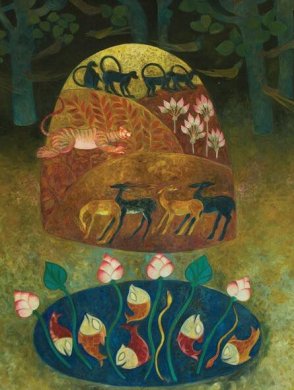 Dinanath Pathy was the father of Contemporary Modern Art of Odisha. A renaissance figure, poet, painter, institution builder, writer, curating international exhibitions for fronting arts, crafts, dance, music, theatre of Odisha, Dinanath has rendered yeoman service to Odisha and built bridges between Odisha and Malaysia with close collaboration with Sutra for more than twenty years. The Odiya artists have created works of great art in Kuala Lumpur exhibited in Kamaria Gallery and Sutra Gallery. In words of Ramli Ibrahim, the painting's composition is centrally and systematically designed. It speaks of an imaginary fauna and fauna-flora utopia of the Soul of Nature supremely balanced in its interconnected existence. Dinanath's ubiquitous Blue Mountain not unlike the mountain tree of life and central puppet entity which opens the Malay-Indonesian shadow play Wayang Kulit, contains the created world - with monkeys, tigers, deer, and foliage – painted in muted earthen terracotta orange brown culminating in a luminous yellow sheath around a blunt peak. A round pool with swimming fish, wriggling snakes and lotus flowers in bluish green hues representing the elemental world of waters, tree trunks and flying birds decorate a dark ominous void of the upper world. Dinanath's paintings remind us that life has no absolutes of his idealistic aspirations as well the reality of destiny over which we have no control. Ramli Ibrahim and Dinanath Pathy's working together has given the world, best dance productions. The very fact that in Malaysia, Odissi, India's exquisite classical dance form has taken roots is a matter of great significance. The tribute to Dinanath with his paintings shall go down in history of two nations as most important landmark. The paintings of other ten painters from Odisha including those of Dilip Tripathy, Ramhari Jena and Kishore were displayed at Sutra Gallery. Indian High Commissioner Mr. T.S. Tirumurty spoke eloquently and explained the significance of The Blue Mountain, the term which has come to us through centuries as mentioned in Kamban's Ramayana when Lakshmana in battle with Indrajit is wounded and falls, Hanuman is asked to go and find the Sanjeevani plant on the Blue Mountain. Lord Jagannath's temple in Puri is located on former Nilachala - blue mountain. Mr. Tirumurty even mentioned how in Harry Potter's account, the mountain is mentioned. He drew attention of young in the audience to connect with history when looking at the paintings. Excerpts of Ganjam: Ramli organizes events with great sensitivity. For four days in the evenings, I used to watch the rehearsals of Ganjam, the choreographic works he mounted with assistance of late Dinanath Pathy incorporating the palm leaf paintings found in Ganjam and traditions of Sakhinata, Daskathia, Prahalad Natak, Tantric Goddesses, and Dashamahavidya in imaginative manner. Assisted by Guru Gajendra Panda, Ramli's production Ganjam is a landmark. Ramli was to perform it at Konark Dance Festival. Watching rehearsals was quite an experience. For warming up exercises, Ramli gives a class in ballet. That helps dancers to have flexibility and their bodies are tuned up for difficult movements. Ramli had training in ballet and was a performer in Sydney Opera House in choreographer Graem's company. During my stay, I learned a lot about Ramli's training methodology. No wonder he has an outstanding dance company. Ramli had planned to present few excerpts after formal inauguration of the exhibition. There is a lovely open air theatre surrounded by luxuriant trees on which dressed in eye catching colourful costumes, dancers trouped in to melodious Odissi music. The pallavi like composition performed by the dancers looked marvelous with excellent lighting by Sivarajah Natarajan. Ramli also presented Devi Moksha number in which the Tantric Goddesses dance both in their terrific and gentle moods. Twelve year old dancer Aishwarya performed with complete involvement and when she is lifted up on shoulder of another dancer and is carried in a procession, the audience burst forth in applause. As emanating elements of Shiva and Parvati, the entire ensemble had stunning visuals. 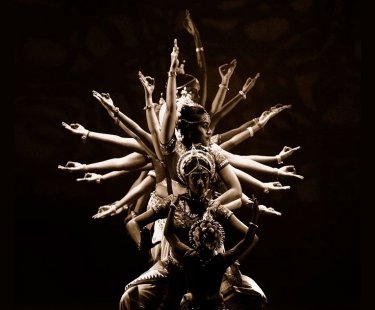
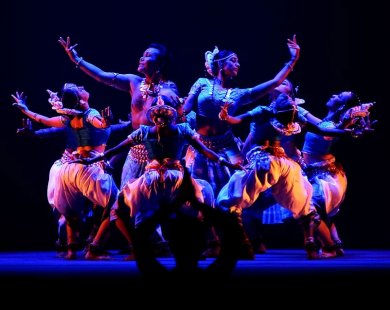
Events at Sutra House, be they an exhibition of photographs, paintings, poetry readings or dance performances, all are well choreographed by Ramli with his sensitive approach. The placement of dinner tables, so that guests can sit in groups and have conversations, were planned meticulously. Fortunately the rain gods were kind. It did not rain. During my stay, Ramli took me to the opening of the Biennale of Kuala Lumpur painting exhibition at Astaya Budan gallery, It was a rare opportunity to see works of so many local artists and photographers. There was one participant from India. Atul Dhandha's work and installation were remarkable. There were also photographs of a well known Bangladeshi photographer. The exhibition was so vast that within a limited time we could not cover everything. It was a privilege to stay with an artist of Ramli's stature sharing love for dance, literature, paintings, arts and crafts and zest for life.  Dr. Sunil Kothari is a dance historian, scholar, author and critic, Padma Shri awardee and fellow, Sangeet Natak Akademi. Dance Critics' Association, New York, has honoured him with Lifetime Achievement award. Post your comments Please provide your name and email id when you use the Anonymous profile in the blog to post a comment. All appropriate comments posted with name & email id in the blog will also be featured in the site. |